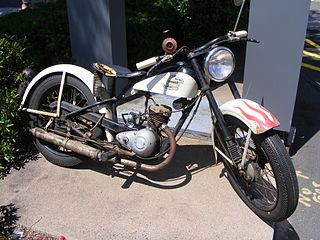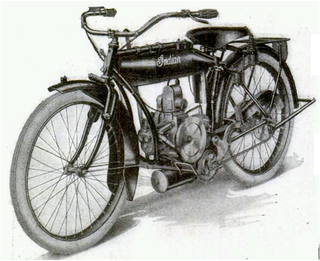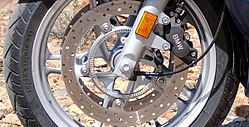
Harley-Davidson, Inc. is an American motorcycle manufacturer headquartered in Milwaukee, Wisconsin, United States. Founded in 1903, it is one of two major American motorcycle manufacturers to survive the Great Depression along with its historical rival, Indian Motorcycles. The company has survived numerous ownership arrangements, subsidiary arrangements, periods of poor economic health and product quality, and intense global competition to become one of the world's largest motorcycle manufacturers and an iconic brand widely known for its loyal following. There are owner clubs and events worldwide, as well as a company-sponsored, brand-focused museum.

Lotus Group is a British multinational automotive manufacturer of luxury sports cars and electric vehicles.

The Lotus Europa name is used on two distinct mid-engine GT cars built by British automobile manufacturer Lotus Cars. The original Europa and its variants comprise the Lotus Types 46, 47, 54, 65 and 74, and were produced between 1966 and 1975.

Lotus Elan is the name of two separate ranges of automobiles produced by Lotus Cars. The first series of cars was produced between 1962 and 1975 as a rear-wheel drive vehicle. The second series was produced between 1989 and 1995 as a front-wheel drive vehicle.

De Tomaso Automobili Ltd. is an Italian car-manufacturing company. It was founded 1959 by Alejandro de Tomaso in Modena. It originally produced various sports prototypes and auto racing vehicles, including a Formula One car for Frank Williams Racing Cars in 1970. Most of the funding for the automaker came from Amory Haskell Jr.

Fordson was a brand name of tractors and trucks. It was used on a range of mass-produced general-purpose tractors manufactured by Henry Ford & Son Inc from 1917 to 1920, by Ford Motor Company (U.S.) and Ford Motor Company Ltd (U.K.) from 1920 to 1928, and by Ford Motor Company Ltd (U.K.) alone from 1929 to 1964. The latter also later built trucks and vans under the Fordson brand.

A softail motorcycle intentionally looks like vintage motorcycles with a rigid hard-tail frame that has a triangle of steel tubes at the rear axle, as on a bicycle frame, but on a Softail these tubes are actually a triangular swingarm, with the shock absorber(s) hidden, as opposed to clearly visible regular twin shocks on both sides of the rear wheel on standard bikes. Since the introduction of the Harley-Davidson FXST Softail in 1983 as a registered trademark of the Motor Company, softail has become a genericized trademark for other models of cruiser motorcycles with rear suspensions hidden for retro style reasons. This was done even though the rear wheel was often hidden behind bags or exhaust pipes.
Erik F. Buell is the founder, former chairman and chief operations officer of the Buell Motorcycle Company, which eventually merged with Harley-Davidson Corp. Buell is a pioneer of modern race motorcycle technology. Buell is also the founder of Erik Buell Racing.

The De Tomaso Vallelunga is a mid-engine sports car produced from 1964 until 1967. It was the first road going automobile manufactured by the company.

Farmall was a model name and later a brand name for tractors manufactured by International Harvester (IH), an American truck, tractor, and construction equipment company. The Farmall name was usually presented as McCormick-Deering Farmall and later McCormick Farmall in the evolving brand architecture of IH.

The Tesla Roadster is a battery electric sports car, based on the Lotus Elise chassis, produced by Tesla Motors from 2008 to 2012. The Roadster was the first highway legal, serial production, all-electric car to use lithium-ion battery cells, and the first production all-electric car to travel more than 244 miles (393 km) per charge. It is also the first production car to be launched into deep space, carried by a Falcon Heavy rocket in a test flight on February 6, 2018.

Unit construction is the design of larger motorcycles where the engine and gearbox components share a single casing. This sometimes includes the design of automobile engines and was often loosely applied to motorcycles with rather different internal layouts such as the flat twin BMW models.
The Harley-Davidson Super Glide was a motorcycle made by the Harley-Davidson. Reputed to be the first factory custom motorcycle, it originated Harley-Davidson's FX series of motorcycles by mating Sportster components, most notably the front end, with the chassis of their larger big twin motorcycles. Super Glide models from 1991 to 2018 were based on the Dyna Glide chassis which has a wider variety of front ends and trim levels, and for a time filled the intermediate niche between the smallest and largest Harley-Davidson models; the Dyna platform has since been discontinued for the 2018 model year in favor of the new Softail frame, with some models from the Dyna nameplate being carried over to the Softail line.

The Harley-Davidson Servi-Car is a three-wheeled utility motorcycle that was manufactured by Harley-Davidson from 1932 to 1973.

A motorcycle frame is a motorcycle's core structure. It supports the engine, provides a location for the steering and rear suspension, and supports the rider and any passenger or luggage. Also attached to the frame are the fuel tank and battery. At the front of the frame is found the steering head tube that holds the pivoting front fork, while at the rear there is a pivot point for the swingarm suspension motion. Some motorcycles include the engine as a load-bearing stressed member; while some other bikes do not use a single frame, but instead have a front and a rear subframe attached to the engine.

The Hummer was a motorcycle model manufactured by Harley-Davidson from 1955 to 1959. However, the name "Hummer" is now incorrectly used generically to refer to all American-made single-cylinder two-stroke Harley-Davidson motorcycles manufactured from 1948 to 1966. These motorcycles were based on the DKW RT125, the drawings for which were taken from Germany as war reparations after World War II. The RT125 drawings were also given to the United Kingdom and the Soviet Union as war reparations, resulting in the BSA Bantam and the MMZ M-1A Moskva, later known as the Minsk.

Samson Tractor was an American brand of tractors 1900 to 1923, of trucks from 1920 to 1923, and a General Motors brand from 1917 to 1923.

The Harley-Davidson Model W, also known as the Sport Twin, is a motorcycle made by Harley-Davidson from 1919 to 1923. Unusually for a Harley-Davidson motorcycle, the Model W had a flat-twin engine and a trailing link fork. The Model W set speed records on runs from New York City to Chicago and from the Canada–United States border to the Mexico–United States border. Slow home market sales led to the end of production after four years.

The Indian Model O was a lightweight motorcycle made by the Hendee Manufacturing Company from 1917 to 1919. Indian expected to sell the Model O to young or thrifty riders. The United States' entry into World War I caused Indian to shift manufacture to military motorcycles, and the low cost of the Ford Model T caused the market for lightweight motorcycles to collapse.

Thames was a commercial vehicle brand produced by Ford of Britain.





















